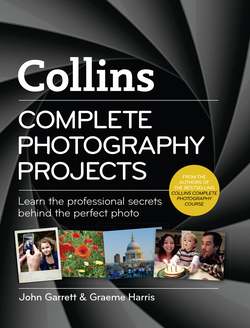Читать книгу Collins Complete Photography Projects - John Garrett - Страница 41
USING FLASH
ОглавлениеWhile the newer digital cameras with high ISO speeds enable photographs to be taken in low light conditions that would previously have required flash, it can still be used as a creative light source even where it’s not essential. However, it should be employed with care to avoid ruining the beauty of natural light.
Most cameras have their own built-in flash, and all manufacturers also make dedicated flash guns for their cameras. These have more power than built-in flashes and because they have their own battery power they don’t drain the camera’s batteries. They fit onto the camera’s hot shoe and, unlike built-in flashes, they have a swivel head so they can bounce light off the wall or ceiling, which can produce a softer effect than direct flash. You can also hand-hold them or use a separate support; the new flash guns can be used off-camera remotely, while older models require a cable to synchronize with the camera.
AVAILABLE LIGHT
The available light version of this young gardener is charming, but his face can’t be seen as clearly as a mother would like. 1/60 second at f9.5, 26mm, 400 ISO. GH
FILL-IN FLASH
Here the camera has balanced the built-in flash with the available light, giving a ‘fill’ light so his face is no longer lost in shadow. 1/100 second at f9.5, with fill-in flash, 26mm, 400 ISO. GH
BUILT-IN FLASH
This is a portrait made with the built-in flash. It is important to underexpose direct flash pictures such as this by about –½ stop to eliminate that bleached-out, pasty look that you see on many direct flash portraits. 1/60 second at f2.8, 6.1mm compact camera, 400 ISO. JG
DIRECT FLASH
This portrait of Jen was taken with the flash gun on the camera pointed directly at her. The direct front light has flattened her face and the highlights are bright. Because the background is further from the light than her face, it is underexposed. 1/180 second at f8, 46mm, 200 ISO. GH
BOUNCE FLASH
With the flash gun still on the camera, I tilted the flash up to bounce the light off the ceiling. I pulled up the white bounce card in the flash head, which has added a little front light to fill in the shadows and put a sparkle in her eyes. This gives a more natural look and the bounce light has lightened the background, too. 1/180 second at f8, 46mm, 200 ISO. GH
OFF-CAMERA FLASH
I removed the flash gun from the camera and held it to the left, giving more modelling to her face. I set the flash to remote mode to synchronize it to the camera, but an off-camera cable would also have done the job. The background and shadows are very dark. 1/180 second at f11, 46mm, 200 ISO. GH
OFF-CAMERA FLASH AND DOME
With the flash still off-camera, I added the diffusing dome to the flash head. The diffuser has spread some light around the room, which has filled in the shadow on Jen’s face and lightened the background. 1/180 second at f8, 46mm, 200 ISO. GH
TURNING DAY INTO NIGHT
This cat portrait was taken with built-in flash. It was afternoon, but I wanted to create a surrealistic feeling of night. Using aperture priority mode, I set the aperture to f10, knowing that I was close enough to adequately light the cat with the flash. To get the dark background I needed to underexpose, which I did by setting the exposure compensation to –3. 1/250 second at f10, 19mm, 500 ISO. JG
USING RED EYE FOR EFFECT
The ‘red eye’ that we all normally try to eliminate can be used as a fun effect. This shot of my little dog makes her look like a devil dog running out of the darkness. Flash also freezes action and can be used solely for that reason, but in this shot I combined the built-in flash with a slow shutter speed to add some movement. 1/60 second at f6.3, 95mm, 400 ISO. JG
